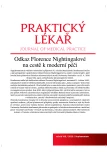-
Medical journals
- Career
Initial experience with the Czech version of the Sydney Swallow Questionnaire
Authors: P. Mandysová 1,2; P. Šolínová 1,3
Authors‘ workplace: Fakulta zdravotnických studií, Univerzita Pardubice 1; Neurologická klinika, Pardubická nemocnice, Nemocnice Pardubického kraje, a. s., Pardubice 2; Všeobecné oddělení neurologie, Fakultní nemocnice Hradec Králové 3
Published in: Prakt. Lék. 2020; 100(Supplementum): 27-32
Category:
Overview
Introduction: Dysphagia is a common problem in patients with neurological conditions. Adequate questionnaires in Czech for self-report of swallowing difficulties are lacking.
Aim: The aim was to translate into Czech and test the Sydney Swallow Questionnaire (SSQ) and to examine the effect of age, cognitive state, and gender on SSQ scores.
Method: Back translation was used to develop the preliminary Czech version, which was utilized in a pre-test that involved neurological patients with diagnosed dysphagia. Specifically, patients were asked to complete the 17-item SSQ (maximum possible score 1700) and were observed for difficulties during its use. Furthermore, the Mini-Cog test was used to assess cognitive status. The relationship between age, cognitive status, and gender on the one hand and the SSQ scores on the other was examined using graphs and the biserial (rPB) and Spearman (ρ) correlation coefficient.
Results: Forty-seven patients (61.7% men; average age 71.3) met the inclusion criteria and were administered the SSQ; however, five patients did not complete all items. Total SSQ scores for the remaining 42 patients ranged from 53–1163 points. The graphs and the correlation coefficient values did not show any significant relationship between SSQ scores and the studied factors. Some patients found that the phrase “average meal” was unclear; almost 40% of the patients needed > 10 minutes to complete the SSQ.
Conclusion: Despite the observed difficulties with using the SSQ, the obtained scores appeared to be unaffected by cognitive test results, gender, and age. Nonetheless, further testing of the SSQ is recommended.
Keywords:
dysphagia – neurological condition – swallowing condition – Sydney Swallow Questionnaire.
Sources
- Belafsky, P. C., Mouadeb, D. A., Rees, C. J., Pryor, J. C., Postma, G. N., Allen, J., & Leonard, R. J. (2008). Validity and reliability of the Eating Assessment Tool (EAT-10). The Annals of Otology, Rhinology, & Laryngology, 117(12), 919–924.
- Borson, S., Scanlan, J. M., Watanabe, J., Tu, S. P., & Lessig, M. (2006). Improving identification of cognitive impairment in primary care. International Journal of Geriatric Psychiatry, 21(4), 349–355. Available at https://doi.org/10.1002/gps.1470
- Búa, B. A., & Bülow, M. (2014). Validation in Swedish of Sydney Swallow Questionnaire. BMC Research Notes, 7, Article No. 742. Available at https://bmcresnotes.biomedcentral.com/articles/10.1186/1756-0500-7-742
- Hazra, A., & Gogtay, N. (2016). Biostatistics Series Module 6: Correlation and Linear Regression. Indian Journal of Dermatology, 61(6), 593–601.
- Holland, G., Jayasekeran, V., Pendleton, N., Horan, M., Jones, M., & Hamdy, S. (2011). Prevalence and symptom profiling of oropharyngeal dysphagia in a community dwelling of an elderly population: a self-reporting questionnaire survey. Diseases of the Esophagus, 24(7), 476–480. Available at https://doi.org/10.1111/j.1442-2050.2011.01182.x
- Mandysová, P. (2019). Metody překladu a transkulturní validace zahraničních nástrojů. Pardubice: Univerzita Pardubice.
- Mandysová, P., Fialová, J., Ehler, E., & Pellant, A. (2014). Criterion validity of the self-report dysphagia assessment tool EAT-10 among neurological patients. Central European Journal of Nursing and Midwiery, 5(4), 137–144. Available at http://periodika.osu.cz/cejnm/dok/2014-04/1-mandysov-fialova-ehler-pellant.pdf
- Mandysová, P., & Škvrňáková, J. (2016). Diagnostika poruch polykání z pohledu sestry. Praha: Grada Publishing.
- Ploughman, M., Austin, M., Stefanelli, M., & Godwin, M. (2010). Applying cognitive debriefing to pre-test patient-reported outcomes in older people with multiple sclerosis. Quality of Life Research, 19(4), 483–487. Available at https://link.springer.com/article/10.1007/s11136-010-9602-z
- Szczesniak, M. M., Maclean, J., Zhang, T., Liu, R., & Cook, I. J. (2014). The Normative Range for and Age and Gender Effects on the Sydney Swallow Questionnaire (SSQ). Dysphagia, 29(5), 535–538.
- Tedla, M., Černý M. et al. (2018). Poruchy polykání. (2. aktualizované vydání). Havlíčkův Brod: Tobiáš.
- Vališ, M., Šimůnek, L., Chrobok, V., Pavelek, Z., Černý, M., Ehler, E., & Kunc, P. (2014). Poruchy polykání u neurologických onemocnění. Praktický lékař, 94(6), 254–258. Vejrostová, H., Pánková, J., Mandysová, P., & Škvrňáková, J. (2012). Subjektivně pociťované potíže při polykání: výzkumné šetření pomocí nástroje EAT-10. Profese online, 5(1), 31–34. Available at http://profeseonline.upol.cz/doi/10.5507/pol.2012.007.html
- Wallace, K. L., Middleton, S., & Cook, I. J. (2000). Development and validation of a self-report symptom inventory to assess the severity of oral-pharyngeal dysphagia. Gastroenterology, 118, 678–687.
Labels
General practitioner for children and adolescents General practitioner for adults
Article was published inGeneral Practitioner

-
All articles in this issue
- Patient satisfaction with the management of acute postoperative pain in a medical facility
- Nurses‘ Role in Prescribing Medication
- Coping of students in study programs General nursing and Paramedic
- Initial experience with the Czech version of the Sydney Swallow Questionnaire
- Clinical simulation as a method in midwifery teaching
- Quality of Life of Patients after Polytrauma in Relation to the Injury Severity Score
- Development of healthcare professionals’ roles – a physician’s perspective
- Factors Influencing Job Satisfaction and Motivation of General Nurses
- Knowledge, Attitudes, and Practices of Oral Care in Mechanical Ventilated Patients
- General Practitioner
- Journal archive
- Current issue
- Online only
- About the journal
Most read in this issue- Factors Influencing Job Satisfaction and Motivation of General Nurses
- Coping of students in study programs General nursing and Paramedic
- Nurses‘ Role in Prescribing Medication
- Clinical simulation as a method in midwifery teaching
Login#ADS_BOTTOM_SCRIPTS#Forgotten passwordEnter the email address that you registered with. We will send you instructions on how to set a new password.
- Career

